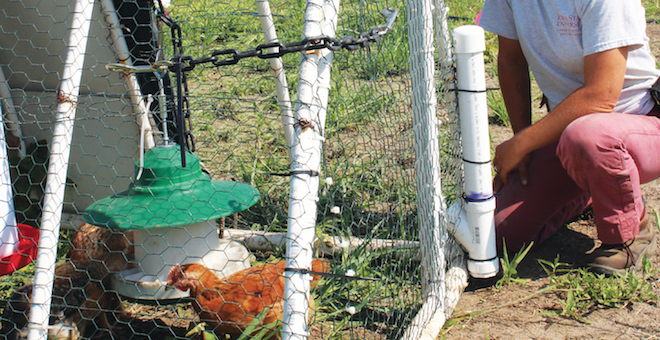

Apr 9, 2019Poultry forage on vegetable crop residue
Vegetables leave crop residue in the field with few ways to use it. Grazing cattle or other large animals can compact the soil. There are advertisements for chickens raised by grazing. Could that work on vegetables? New research at Iowa State University (ISU) says it may.
“Spring-planted vegetable crops leave significant amounts of residue on the soil,” said Ajay Nair, associate professor in ISU’s Horticulture Department. “It’d be an advantage for our growers if we can grow chickens on it.”
Chicken production isn’t uncommon among Midwestern vegetable growers – especially smaller producers. It provides more income and is one of the least capital-intensive livestock enterprises.
“Chickens are frequently raised by vegetable growers as a separate enterprise,” said Moriah Bilenky, ISU graduate research assistant on the project. The ISU study is trying to integrate the vegetable and animal enterprises by evaluating broiler production on the crop residues and seeing if the birds’ droppings improve soil quality.
“These are broiler chickens,” Nair said. “They stay in the field for six to eight weeks until they’re a marketable size, and then they’re gone.”
Three rotations of vegetable and cover crops on land certified for organic production are being evaluated.
The first is a spring vegetable crop, like broccoli or lettuce, with the chickens foraging in mid-summer. Foraging by the chickens is followed by a cereal rye cover crop.
The second rotation is a spring vegetable followed by a cereal rye cover crop with the chickens foraging in the fall.
The third rotation doesn’t include foraging by chickens and is either a spring vegetable followed by a fall vegetable or a season-long vegetable, like tomatoes or peppers. Both trials are followed by a cover crop.
The chickens are placed in moveable pens with water, a coop for shelter and a full ration of organic feed. The pens protect the chickens from flying predators while taller, electric fencing around the whole field provides protection from other predators.
The pens are moved as the chickens finish foraging on the enclosed area’s vegetable residue or cover crop. “A lot of smaller growers who also raise chickens use some style of moveable pen,” Bilenky said.
The project’s use of pens was approved by ISU’s Institutional Animal Care and Use Committee (IACUC). IACUC has local workgroups researchers must use to ensure high standards of animal care and use, and to comply with the Animal Welfare Act and other federal guidelines and policies.
Selecting the right chicken breed for foraging is important.
“Some breeds are great for meat purposes, but the birds don’t move that much in a field environment,” Nair said. “We wanted a breed that will move around, and pick at the ground, looking for food.”
Imperial and Red Ranger are the breeds used by ISU researchers.
“They’re more adaptable and a little more comfortable being housed outside,” Nair said.
Imperial and Red Ranger chickens are usually slower growing and produce smaller carcasses than the chicken breeds most commonly used in confinement systems.
“Compared to your typical broiler these slower growing types have larger legs and thighs, and a narrower breast, which results in a bird that is more proportional and more active – traits ideal for foraging,” Bilenky said. “Imperials and Red Rangers are more active, better suited to outdoor production and better able to forage.”
This is only the second year of the study, but the early results are positive. The chickens have adapted to the pens, successfully grazed on vegetable residue and reached marketable size.
“This is an easy way to get a return after spring harvest,” Nair said. “Graze chickens for eight weeks and then plant your cover crop. This is another tool in the toolbox when we talk about diversifying and integrating vegetables with other enterprises.”
“A big issue we’re looking at is whether or not introducing chickens into a vegetable cropping system can increase soil health,” Bilenky said. “That’s something we’re only going to know in the long term and is why this is a long-term study.”
“Does adding animals to a vegetable farm improve the soil and reduce inputs?” Nair asked. “Can a crop rotation like this work in Iowa’s short grazing season? Does the system make economic sense? Can growers make it work?”
“There’s a push for sustainability and growers understand that,” Nair said. “Growers understand the importance of improving the soil and reducing the need for off-farm inputs.”
— Dean Peterson, VGN correspondent














